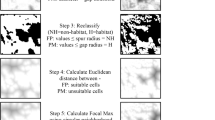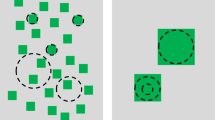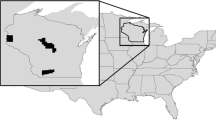Abstract
The discipline of landscape ecology recognizes the importance of measuring habitat suitability variables at spatial scales relevant to specific organisms. This paper uses a novel multi-scale hierarchical patch delineation method, PatchMorph, to measure landscape patch characteristics at two distinct spatial scales and statistically relate them to the presence of state-listed endangered yellow-billed cuckoos (Coccyzus americanus occidentalis) nesting in forest patches along the Sacramento River, California, USA. The landscape patch characteristics calculated were: patch thickness, area of cottonwood forest, area of riparian scrub, area of other mixed riparian forest, and total patch area. A third, regional spatial variable, delineating the north and south portions of study area was also analyzed for the effect of regional processes. Using field surveys, the landscape characteristics were related to patch occupancy by yellow-billed cuckoos. The area of cottonwood forest measured at the finest spatial scale of patches was found to be the most important factor determining yellow-billed cuckoo presence in the forest patches, while no patch characteristics at the larger scale of habitat patches were important. The regional spatial variable was important in two of the three analysis techniques. Model validation using an independent data set of surveys (conducted 1987–1990) found 76–82% model accuracy for all the statistical techniques used. Our results show that the spatial scale at which habitat characteristics are measured influences the suitability of forest patches. This multi-scale patch and model selection approach to habitat suitability analysis can readily be generalized for use with other organisms and systems.








Similar content being viewed by others
References
Agresti A (2002) Categorical data analysis. Wiley-Interscience, New York
Bailey SA, Haines-Young RH, Watkins C (2002) Species presence in fragmented landscapes: modelling of species requirements at the national level. Biol Conserv 108:307–316
Belding L (1890) Land birds of the pacific district. California Academy of Sciences, San Francisco
Bissonette JA (1997) Scale-sensitive ecological properties: historical context, current meaning. In: Bissonette JA (ed) Wildlife and landscape ecology. Springer-Verlag, New York, pp 3–31
Bradley CE, Smith DG (1986) Plains Cottonwood recruitment and survival on a prairie meandering river floodplain, milk river, Southern Alberta and Northern Montana. Can J Bot-Rev Can Bot 64:1433–1442
Breiman L, Friedman J, Olshen RA, Stone CJ (1984) Classification and regression trees. Wadsworth, Belmont
Buler JJ, Moore FR, Woltmann S (2007) A multi-scale examination of stopover habitat use by birds. Ecology 88:1789–1802
Calabrese JM, Fagan WF (2004) A comparison-shopper’s guide to connectivity metrics. Front Ecol Environ 2:529–536
ESRI (2003) ArcGIS 8.3. Environmental Systems Research Institute, Redlands
Fuhlendorf SD, Woodward AJW, Leslie DM, Shackford JS (2002) Multi-scale effects of habitat loss and fragmentation on lesser prairie-chicken populations of the US Southern Great Plains. Landscape Ecol 17:617–628
Gaines D, Laymon SA (1984) Decline, status and preservation of the yellow-billed cuckoo in California. West Birds 15:49–80
Girvetz EH, Greco SE (2007) How to define a patch: a spatial model for hierarchically delineating organism-specific habitat patches. Landscape Ecol 22:1131–1142
Greco SE (2008) Long-term conservation of the yellow-billed cuckoo will require process-based restoration on the Sacramento River. Ecesis 18:4–7
Greco SE, Plant RE (2003) Temporal mapping of riparian landscape change on the Sacramento River, miles 196–218, California, USA. Lands Res 28:405–426
Greco SE, Plant RE, Barrett RH (2002) Geographic modeling of temporal variability in habitat quality of the yellow-billed cuckoo on the Sacramento River, miles 196–219, California. In: Scott JM et al. (eds) Predicting Species Occurrences: Issues of Accuracy and Scale. Island Press, Covelo, pp 183–195
Greco SE, Tuil JL, Parker TM (2003) Land cover mapping of the Sacramento River from 1997 aerial photography. Technical report for the California Department of Water Resources. Landscape Analysis and Systems Research Laboratory, University of California, Davis
Greco SE, Fremier AK, Larsen EW, Plant RE (2007) A tool for tracking floodplain age land surface patterns on a large meandering river with applications for ecological planning and restoration design. Landsc Urban Plan 81:354–373
Grinnell J, Miller AH (1944) The distribution of the birds of California. Pacific Coast Avifauna No. 27. The Cooper Ornithological Club, Berkeley
Halterman MD (1991) Distribution and habitat use of the yellow-billed cuckoo (Coccyzus americanus occidentalis) on the Sacramento River, California, 1987–1990. California State University, Chico, 49 pp
Halterman MD, Gilmer DS, Laymon SA, Falxa GA (2001) Status of the yellow-billed cuckoo in California, 1999–2000. USGS-BRD-WERC final report submitted to USFWS. USBR
Johnson RR, Brown BT, Haight LT, Simpson JM (1981) Playback recordings as a special avian censusing technique. In: Ralph CJ, Scott JM (eds) Studies in avian biology. Allen Press, Lawrence, pp 69–75
King AW (1997) Hierarchy theory: a guide to system structure for wildlife biologists. In: Bissonette JA (ed) Wildlife and landscape ecology. Springer-Verlag, New York, pp 185–212
Kotliar NB, Wiens JA (1990) Multiple scales of patchiness and patch structure—a hierarchical framework for the study of heterogeneity. Oikos 59:253–260
Larsen EW, Fremier AK, Girvetz EH (2006) Modeling the effects of variable annual flow on river channel meander migration patterns, Sacramento River, California, USA. J Am Water Resour Assoc 42:1063–1075
Laymon SA (1980) Feeding and nesting behavior of the yellow-billed cuckoo in the Sacramento Valley. State of California Department of Fish and Game, Sacramento, p 29
Laymon SA, Halterman MD (1989) A proposed habitat management plan for yellow-billed cuckoos in California. In: Proceedings of the California Riparian Systems Conference: protection, management and restoration for the 1990’s, pp 272–277. USDA Forest Service General Technical Report PSW-110, Berkeley, CA, USA
Mac Nally R (2000) Regression and model-building in conservation biology, biogeography and ecology: the distinction between and reconciliation of ‘predictive’ and ‘explanatory’ models. Biodivers Conserv 9:655–671
Mac Nally R (2002) Multiple regression and inference in ecology and conservation biology: further comments on identifying important predictor variables. Biodivers Conserv 11:1397–1401
Mahoney JM, Rood SB (1998) Streamflow, requirements for cottonwood seedling recruitment—an interactive model. Wetlands 18:634–645
McGarigal K, Cushman SA, Neel MC, Ene E (2002) FRAGSTATS: spatial pattern analysis program for categorical maps. University of Massachusetts, Amherst, MA, USA. www.umass.edu/landeco/research/fragstats/fragstats.html
Milne BT (1997) Applications of fractal geometry in wildlife biology. In: Bissonette JA (ed) Wildlife and landscape ecology. Springer-Verlag, New York, pp 101–127
Nelson C (2000) Sacramento River riparian vegetation coverage metadata. Geographic Information Center, California State Univeristy, Chico
Poff NL, Allan JD, Bain MB, Karr JR, Prestegaard KL, Richter BD, Sparks RE, Stromberg JC (1997) The natural flow regime. Bioscience 47:769–784
Rood SB, Samuelson GM, Braatne JH, Gourley CR, Hughes FMR, Mahoney JM (2005) Managing river flows to restore floodplain forests. Front Ecol Environ 3:193–201
R-project (2006) R statistical package 2.4.1. The R foundation for statistical computing. http://www.r-project.org
Saab V (1999) Importance of spatial scale to habitat use by breeding birds in riparian forests: a hierarchical analysis. Ecol Appl 9:135–151
Scott JM, Jeglund PJ, Samson F, Haufler J, Morrison M, Raphael M, Wall B (eds) (2002) Predicting species occurrences: issues of accuracy and scale. Island Press, Covelo
Talley TS (2007) Which spatial heterogeneity framework? Consequences for conclusions about patchy population distributions. Ecology 88:1476–1489
Turner MG, Gardner RH, Oneill RV (2001) Landscape ecology in theory and practice. Springer-Verlag, New York
Verner J, Morrison ML, Ralph CJ (eds) (1986) Wildlife 2000: modeling habitat relations of terrestrial vertebrates. University of Wisconsin Press, Madison
Wiens JA (1976) Population Responses to Patchy Environments. Annu Rev Ecol Syst 7:81–120
With KA (1997) The application of neutral landscape models in conservation biology. Conserv Biol 11:1069–1080
Wu JG, Loucks OL (1995) From balance of nature to hierarchical patch dynamics: a paradigm shift in ecology. Q Rev Biol 70:439–466
Acknowledgments
The authors would like to thank Marcel Holyoak, Jim Quinn, and Chrissy Howell for useful comments to the manuscript. This work was partially funded by the California Department of Water Resources under Interagency Agreements #4600000736 and #4600001950, and EHG was partially funded by a block grant from the University of California, Davis, Graduate Group in Ecology.
Author information
Authors and Affiliations
Corresponding author
Rights and permissions
About this article
Cite this article
Girvetz, E.H., Greco, S.E. Multi-scale predictive habitat suitability modeling based on hierarchically delineated patches: an example for yellow-billed cuckoos nesting in riparian forests, California, USA. Landscape Ecol 24, 1315–1329 (2009). https://doi.org/10.1007/s10980-009-9384-2
Received:
Accepted:
Published:
Issue Date:
DOI: https://doi.org/10.1007/s10980-009-9384-2




